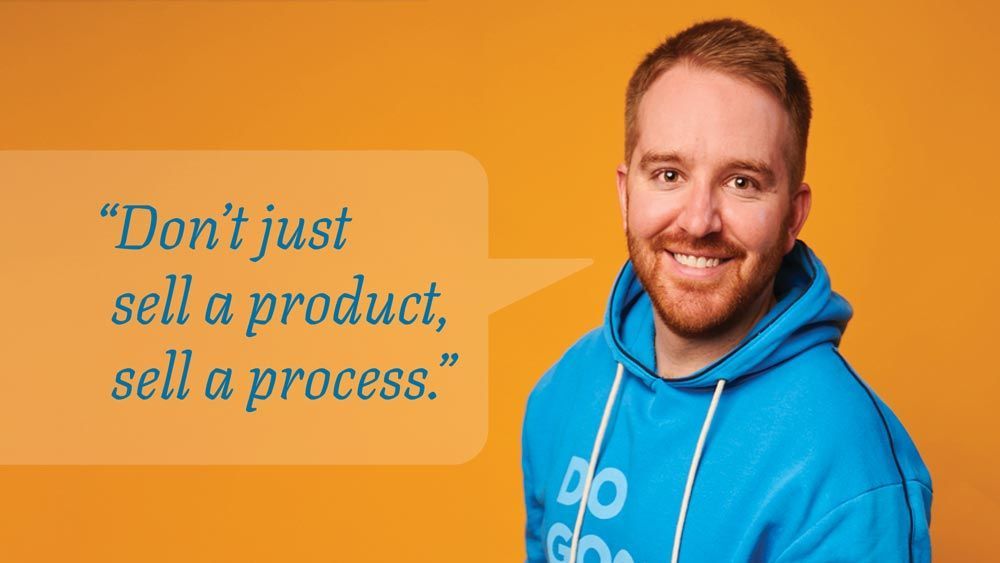Branding vs. Marketing: Why Marketing is Important for your Brand
It may be odd to discuss what is more important — branding or marketing — during a global pandemic and national emergency. People increasingly look to business and business leaders to provide guidance, reassurance, and information.
What is the difference between marketing and branding?
It's ridiculous to argue about what's more important, branding or marketing. It's important to understand the difference between branding and marketing so you know how they work together to attract, inspire, and engage customers and create raving fans. (I recommend listening to Chris Do discuss the merits of both marketing and branding with Melinda Livsey and Fabian Geyrhalter).
Every day, people tell themselves stories about what they need, how they want to feel, who they are, and who they want to become.
That’s why it’s important to start with a simplified definition of brand and marketing. When brand and marketing are made simple, it’s easier for entrepreneurs, business owners, and business leaders to cut through the jargon and get to the essentials that help them pivot quickly and take action now.
When we say, “everybody brands,” we mean that it’s the interplay between your brand strategy and marketing that creates the environment and experience for your customers.
Branding takes shape in the mind of your customer — in the interplay between what your brand says it stands for and how it behaves — and your customer’s experience and how that experience makes them feel. Marketing makes the brand familiar and helps create a customer’s experience with the goal of trust and loyalty — two brand virtues.
Listen to this article, The Difference Between Branding and Marketing
Simple definitions for branding and marketing
- A brand is a person’s gut feeling about your product, service, organization, or cause, and how it fits into their lifestyle (how they live their life) or worldview (what they value). Your brand isn’t what you say it is, it’s what they (your customers) say it is.
- In storytelling language, a brand is a story people tell themselves about what you offer and how it fits into their lifestyle or worldview, and how the brand makes them feel. It’s the voice they hear speaking to them when something triggers a memory or recollection of your product or service.
- Branding is the strategy and process of defining and articulating the purpose, character, and culture that differentiate your brand and its unique voice so people identify with your product, service, organization, or cause.
- Marketing is storytelling. It’s how you invite people into your brand story so they can clearly hear its voice and be confident the brand can help them solve their problem or become who they want to be. The marketer’s voice tells a story about how the brand helps the customer (benefits); how they will feel (experience); and who they will become (identity).
Download a free ebook, 8 Things Every Website Needs to Engage Customers, to find out what simple changes you can make so your brand is trusted and authentic.
Branding and Marketing in Times of Crisis
Your focus should be on marketing and communications that tell people your brand is listening, cares about them, and wants to help.
During a crisis of any kind — pandemic, natural disaster, national emergency — people are feeling a great deal of uncertainty. Your messaging and interactions need to help people feel safe, connected, and in control.
Employees and customers are looking to business leaders for assurance, information, and guidance. Now more than ever, it’s critical that your brand is the guide, striking a balance between empathy and authority.
Keep these considerations in mind:
- What messaging with empathy looks like is different for every business and brand.
- Don’t stop communicating. While the world hits pause — hit play — because hope moves forward and the world needs hope right now.
A simple way to pivot your messaging
Work through this simple exercise to help you pivot your marketing messaging to best speak to how people feel during a crisis:
- My customers used to feel/be this way: (confident, optimistic, successful).
- Now my customers feel/are: (uncertain, cautious, failing).
For example:
- My customer used to be busy — now they are restless and bored at home.
- My customers used to be optimistic about the future — now they are cautious.
- My customers used to be risk-takers — now they want to minimize risk.
- My customers used to be well-connected — now they are socially distant.
- My customers used to be epic adventurers — now they just want to recreate.
Three ways to engage with your customers
Brands that survive and thrive will demonstrate a high level of trust, authenticity, transparency, and on a personal level.
- Contact your customers to stay connected and meet their need for being engaged.
- Connect with your customers to let them know you care about how they are doing and meet their need for safety and security.
- Care about your customers by asking them how you can help to meet their desire for being empowered and having a sense of control.
When you let people know your brand is listening, cares about them, and wants to help, it’s easier to pivot messaging to what people need to hear at this moment.
Marketing should be simple and it should work. Get started by creating a marketing funnel that will help your business survive... and thrive.
Why are marketing and branding important?
Everything is connected in a system.
The business, product, service, brand, and customer elements are connected. You must think of your company as a system governed by a purpose, and design the relationships between the company and the customer.
People are more likely to do business with brands they know and trust, especially when you understand their goals and motivations.
Right now, people are feeling a great deal of uncertainty. Your messaging needs to pivot to help people feel safe, connected, and in control.
- During a crisis, people feel cautious and insecure: Your communications and messaging needs to help them feel safe and secure.
- During an emergency, people feel disconnected: Your communications and messaging needs to help them feel connected especially if your product or service can help them strengthen connections with each other.
- During a crisis, people feel a loss of control: Your communications and messaging needs to help people feel empowered and in control. Giving people a sense of personal power and purpose are two ways to drive emotional engagement right now.
How to create Brand Messaging during a Crisis
Reframe your messaging and the choices you offer people
If your brand provides protection and security:
- If you used to promise success, shift from promotion to protection with offers that help them lower chances of losing control.
- Security is defined as the desire to feel safe and protected from the threat.
- For instance, financial services can shift from growth to protection.
- Speak to minimizing risk.
- People are forced to stay at home — think about how your brand can provide a sense of security in their home or business.
If your brand offers control and empowerment:
- Empowerment is the desire to feel in control, authorized, and equipped to act.
- Give people hope that they have a say in their future.
- For example, one thing you can control is how you message to your customers and prospects.
If your brand offers connection and engagement:
- Provide relief or hope in your messaging.
- Engagement is the desire to feel captivated, excited, and absorbed in activity.
- Tell people how you can help them experience more significant relief where they are.
- Talk about how your brand can help people connect with people they care about.
- Florists, this is a great time to recognize that while you can’t see people you love in person, you can send them flowers to show you care.
Right now, your focus should be on marketing and communications that tell people your brand is listening, cares about them, and wants to help. Your marketing will reveal your brand character, and your brand’s voice must be clear and consistent in your marketing.
When you’ve reframed your messaging and the customer’s choice in a way that speaks to the way they feel and view the world, your brand is more likely to influence their choice when they make a decision what to buy or who to buy from in the moment.
That’s how branding and marketing work together during a crisis.
Marketing Leads to Relationships
Building a brand is a long-term plan. You make it meaingful when you position the ideal customer as one that can fall in love with your brand.
Marketing falls short when it only invites people into a story. Marketing must invite people into a relationship with a brand they can know, trust, and love.
Marketing and branding are co-dependent
Brands create and store value, marketing is an expense. A brand becomes more valuable through marketing. Marketing is more effective when the brand expresses the value the customer gets from it.
Branding reflects character and brand personality flows from the words and messaging that a brand chooses to represent itself.
Branding is the process of forming identity and likability.
Branding is also the process of defining the personality and character of your brand so it awakens a need for connection (engages the curious), nurtures belief and trust (enlightens the interested), and deepens the desire to act by inviting people into relationship (compels the committed). Your goal should be to clarify your message so you become more relevant to fewer people.
Marketing help you attract the curious; branding helps you keep them engaged.
Marketing invites people to experience your brand. Branding is the person that opens the doorway and says to the customer, “You first.”
Photo by Daria Shevtsova from Pexels
Do you have a hard time explaining what your company does or why your brand matters to people?
If you struggle to grow your business, you’re not alone. Aespire can help you create a clear message and brand that helps you grow your business. Contact us today for a consultation with a StoryBrand Certified Marketing Guide.
Get a Free Comprehensive Marketing Assessment
Stop hoping your marketing will sort itself out.
- Complete this free assessment in 15 minutes.
- Review your custom report (and schedule a 30-minute review) to diagnose what’s happening.
- Create an action plan to get your marketing back on track.







